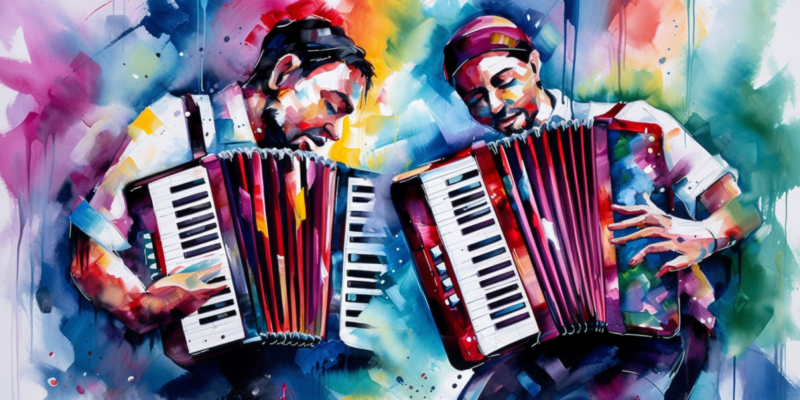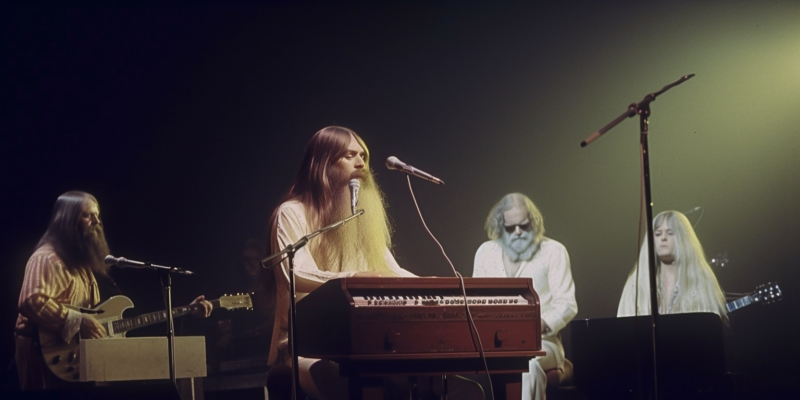- Musical variety and exploration: Richard Vahrman, being a renowned jazz accordion player, might choose to create a medley from “The Bear” by John Mayall, “Delta Lady” by Leon Russell, and “When Your Train Gets Lost” by Bob Dylan to showcase his versatility and adaptability as a musician. Combining these three songs, which come from different genres and have distinct styles, would allow Vahrman to demonstrate his ability to seamlessly weave together diverse musical elements while adding his unique jazz accordion touch to each piece.
- Emotional connection and storytelling: Each of these songs conveys a different emotional tone and narrative, offering an opportunity for Vahrman to create a rich and engaging musical journey for his audience. “The Bear” showcases a bluesy, introspective mood, “Delta Lady” has a soulful, passionate vibe, and “When Your Train Gets Lost” presents a folk-rock sound with a sense of longing and reflection. By combining these songs, Vahrman can take listeners on an emotional roller coaster, allowing them to experience a wide range of feelings and stories through his medley.
- Paying tribute to influential musicians: By choosing songs from John Mayall, Leon Russell, and Bob Dylan, Richard Vahrman may be paying homage to these influential artists and their impact on the music world. These musicians have each made significant contributions to their respective genres and have inspired countless other artists, including Vahrman himself. By creating a medley of their songs, Vahrman can honor their legacies while also showcasing his own interpretation and style, breathing new life into these classic tunes through his jazz accordion arrangements.
Nature Boy (which one?)
“Nature Boy” is a song written by Eden Ahbez and first recorded by Nat King Cole in 1948. The song has since been covered by numerous artists. The lyrics tell the story of a “strange enchanted boy” who travels far and wide, only to learn that “the greatest thing you’ll ever learn is just to love and be loved in return.”
The song’s message is often interpreted as a celebration of love and the importance of human connection. It emphasizes that love is the most essential and powerful aspect of life. The “Nature Boy” character can be seen as a representation of someone who has experienced the world and all its complexities, yet ultimately discovers that love is the most important lesson to learn.
The mystical and poetic nature of the lyrics has led to various interpretations over the years. Some listeners see the “Nature Boy” as a symbol of the non-conformist or free-spirited individual who goes against societal norms to seek truth and wisdom. The song’s message resonates with the idea that true happiness and fulfillment can be found in love and connection with others, rather than material possessions or social status.
In summary, the lyrics of “Nature Boy” convey a timeless and profound message about the importance of love and the human connection in our lives. The song reminds us that, regardless of our experiences or the paths we take, love remains the most essential lesson to learn and cherish.
Night Life (during the day)
Dear Richard,
I wanted to take a moment to express my admiration for your adaptation of my song “Night Life.” The moment I heard your rendition, I was captivated by the unique and captivating spin you’ve put on it with your accordion.
Your skillful playing brings a depth and richness to the melody that I never imagined possible. The way you’ve transformed “Night Life” into a soulful and evocative piece showcases not only your tremendous talent but also your deep understanding of the essence of the song. Your interpretation has breathed new life into my work, and for that, I am truly grateful.
Furthermore, the passion and emotion that you pour into your performance make it clear that you have a genuine connection to the music. It’s evident that you’ve put your heart and soul into this adaptation, and the result is nothing short of mesmerizing.
I am truly honored that an artist of your caliber has chosen to interpret my song, and I am excited to see what other musical magic you will create in the future. Thank you for sharing your gift with the world and for giving “Night Life” a fresh and unforgettable twist.
With my deepest admiration and appreciation,
Willie Nelson
Atmospherix: a duo’s remarkable sound in the cosiest of spaces
In the bustling world of jazz and blues, it is not uncommon for musicians to seek out innovative ways to make their mark. Among these trailblazers are a jazz duo who, despite wielding nothing more than an accordion and a cajon, manage to create a sonic experience akin to a full band, all while fitting snugly into the tiniest nooks and crannies of any venue.
The accordionist, a master of their instrument, breathes life into each melody with a finesse that belies the complex layers of harmony and rhythm they produce. The rich and robust tones of the accordion fill the room, enveloping the audience in a lush tapestry of sound that defies expectations.
Meanwhile, the cajon player, seated upon their unassuming wooden box, brings forth an astonishing array of rhythms and textures. From the deep, resonant bass notes to the crisp, intricate snare sounds, this skilled percussionist crafts a rhythmic foundation that propels the duo’s music forward with an irresistible energy.
Together, these two musicians weave an auditory tapestry that is at once intimate and expansive, their chemistry palpable as they play off one another’s musical cues. The duo’s ability to sound like a full band stems from their keen understanding of each instrument’s potential and their unwavering dedication to their craft.
Remarkably, this dynamic jazz duo manages to achieve their impressive sound while occupying the most modest of spaces. A small corner of the room, often reserved for a potted plant or a decorative piece of furniture, becomes the duo’s stage, transforming even the most cramped venues into vibrant, pulsating jazz clubs.
Audiences are consistently captivated by the duo’s capacity to create such a rich, full-bodied sound from just two instruments, all within a compact, unobtrusive setup. As the notes of their lively jazz tunes dance through the air, listeners are transported to a world where space is no constraint, and the only limits are those of the imagination.
This extraordinary jazz duo serves as a reminder that, in the realm of music, innovation and creativity can transcend physical boundaries. In their hands, the accordion and cajon become a veritable orchestra, proving that size truly does not matter when it comes to making a lasting impression in the world of jazz.
Psychospherix: lights, camera, action, exotic fruit.
Meet the experimental duo crafting melodic masterpieces with handmade electronic instruments. In the ever-evolving landscape of jazz music, a groundbreaking duo has emerged, pushing the boundaries of conventional instrumentation and performance. Armed with an eclectic collection of unusual, handmade electronic instruments and accompanied by a rotation of special guests, this experimental jazz duo captivates audiences with their melodic compositions and mesmerizing visual backdrops.
Eschewing the frenetic cacophony of free jazz, this duo instead weaves a rich tapestry of melodies and harmonies that speak to the listener on an emotional level. Their music is characterized by a unique blend of electronic sounds, shaped by the skillful hands of the artists as they manipulate their custom-made instruments.
From synthesizers constructed out of repurposed household items to drum machines fashioned from found objects, the duo’s unconventional arsenal is a testament to their creativity and ingenuity. Each instrument is a work of art in its own right, reflecting the vision and dedication of the musicians who crafted them.
Accompanying the duo are an ever-changing lineup of special guests, each bringing their own unique talents and perspectives to the mix. These collaborations serve to enhance the duo’s sonic explorations, providing fresh input and ideas that keep their music invigorating and unpredictable.
Perhaps the most striking aspect of the duo’s performances is the integration of video backdrops that serve to heighten the sensory experience. As the musicians coax otherworldly sounds from their handmade instruments, the visuals projected behind them envelop the audience in an immersive atmosphere that complements the music perfectly. This symbiosis of sound and vision blurs the lines between performance art and jazz, creating a truly unforgettable experience.
Despite their avant-garde approach, the duo’s music remains accessible and melodic, drawing in listeners who might otherwise shy away from experimental jazz. Their compositions are intricate, yet always grounded in a deep sense of musicality that makes them resonate with a wide range of audiences.
This innovative jazz duo has truly carved out a niche for themselves within the genre, proving that even the most well-trodden musical paths can still yield exciting new discoveries. With their handmade electronic instruments, captivating visuals, and melodic sensibilities, they continue to push the boundaries of what jazz can be, inspiring others to follow in their footsteps and explore the limitless possibilities of music.
Delta Lady: Unraveling the Lyrics of Leon Russell
Rock and roll: few songwriters have managed to capture the raw emotion and sheer soulfulness of the genre quite like Leon Russell. Among his many notable compositions, “Delta Lady” stands out as a testament to his lyrical prowess and his ability to weave a compelling narrative through song. In this article, we will unravel the lyrics of this iconic track, shedding light on the depth and beauty that lies beneath its catchy melody.
Released in 1969 on his eponymous debut album, “Leon Russell,” “Delta Lady” is a soulful ballad that tells the story of a captivating woman from the Mississippi Delta. At first listen, the song appears to be a simple love song, but upon closer examination, the lyrics reveal a complex portrait of a woman who is both alluring and mysterious.
The opening lines of the song set the stage for the tale that unfolds: “Woman of the country now I found you / Longing in your soft and fertile delta.” Here, Russell uses vivid imagery to paint a picture of the Delta Lady, invoking her connection to the natural world and the Mississippi Delta’s rich, fertile landscape. The use of the word “delta” not only evokes the region’s geography but also suggests the convergence of different influences, hinting at the multifaceted nature of the woman herself.
As the song progresses, Russell delves deeper into the character of the Delta Lady, describing her as “a woman of a certain age” who has experienced love and loss: “And I whispered sighs to satisfy your longing / For the warmth and tender shelter of my body.” These lines reveal a vulnerable side to the Delta Lady, a woman who has known both passion and heartbreak and who seeks comfort and solace in the arms of her lover.
In the chorus, Russell proclaims his devotion to the enigmatic Delta Lady, pledging his love and loyalty to her: “Oh, Delta Lady / Don’t you know I love you / Don’t you know I’ll always be around?” This heartfelt declaration is underscored by the soaring melody and lush instrumentation, heightening the emotional impact of the lyrics.
The song concludes with a poignant reflection on the fleeting nature of love and the passage of time: “When I lose my weary blues / By loving in the country for a while.” Here, Russell acknowledges that even the deepest love can fade, but the memory of the Delta Lady and their time together will always remain a source of comfort and solace.
“Delta Lady” is a masterful example of Leon Russell’s songwriting ability, blending poetic imagery, heartfelt emotion, and a captivating narrative to create a timeless classic. By unraveling the lyrics of this iconic track, we gain a deeper appreciation for Russell’s talent and the enduring appeal of his music. Through his evocative storytelling, Russell immortalizes the enigmatic Delta Lady, ensuring that her spirit continues to resonate with listeners for generations to come.


